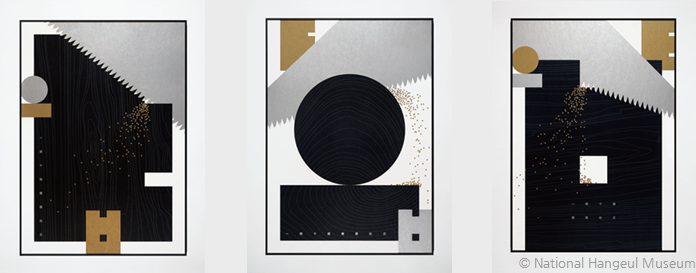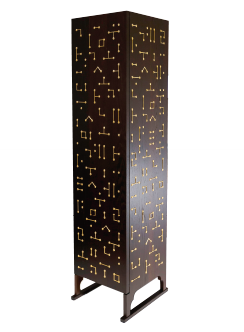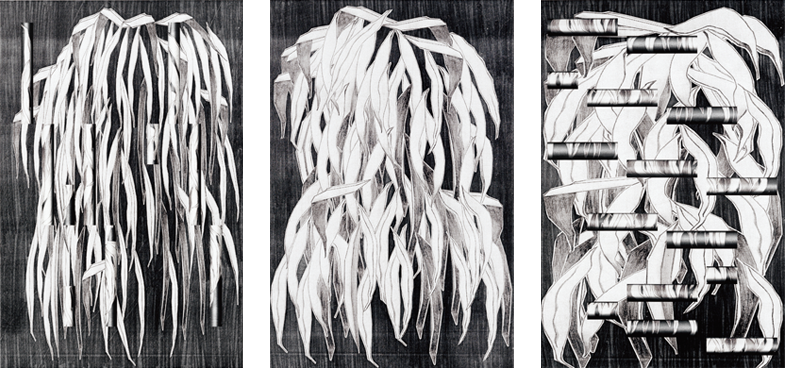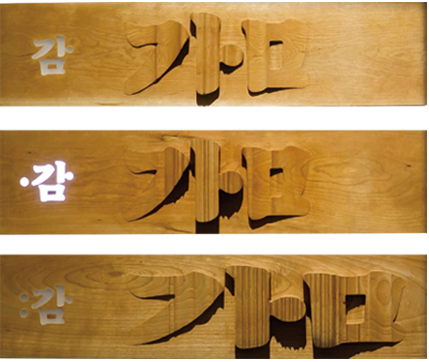A special exhibition at the National Hangeul Museum shed light on the current status of
Hangeul as a fast-changing script and its future as the alphabet of a unified Korea. “Hangeul
Design: Prototypes and Future of the Korean Alphabet,” held from February 28 to May 28,
2017, offered visitors a chance to look back at the birth of Korea’s unique writing system and
into its future through the works of young design artists.
Transparent acrylic sheets stand in the dimly-lit
entrance to the special exhibition “Hangeul Design:
Prototypes and Future of the Korean Alphabet”
at the National Hangeul Museum, showing all 33
pages of “Hunminjeongeum Haerye,” a commentary
explaining the principles of the new Korean
writing system published in 1446 when the script
was promulgated.
In 1443, King Sejong, the fourth ruler of the Joseon Dynasty, completed
the invention of a new Korean writing system called Hunminjeongeum,
the original name of Hangeul. It was the fruition of painstaking
efforts by a wise monarch who had tried to solve social inequality
and challenges in state administration. Most people had difficulties
expressing themselves freely because the nation had been relying on
Chinese characters or an archaic writing system called Idu, a combination
of Chinese characters and grammatical markers used by the
learned elite. In 1446, after three years of extensive research and experiments,
Sejong published “Hunminjeongeum Haerye,” a book explaining
the phonological features of the letters and examples of their usage.
In his preface, the king said: “Despite their desire to communicate,
many of our poor people cannot express themselves in words freely.
Taking pity on them, we have created a new set of 28 letters. My only
wish is that all the people may learn these letters with ease and use
them conveniently in their everyday lives.”
As I stepped into the dimly-lit exhibition hall, I felt as if I was hearing
the voice of the great king.

“톱” (Top; “Saw”) by Chae Byung-rok portrays the meaning of the word “톱” by dissecting it into three parts — “ㅌ,”
“ㅗ” and “ㅂ” — corresponding to the initial, medial and fi nal sounds.

“장석장” (Jangseokjang; “Ornamental Furniture”) by Ha Jee-hoon is a piece of wooden furniture decorated with
metal ornaments in the shape of Hangeul consonants and vowels, in similar fashion to the traditional wooden furniture
of the Joseon Dynasty.
creation of a New Writing System
Since its opening on Hangeul Day on October 9, 2014, the National
Hangeul Museum has devoted itself to promoting the history and value
of Hangeul through special exhibitions and other events. The museum
focused on the originality and usefulness of Korea’s unique writing system,
which is all too easily forgotten as people use it in their everyday
lives like breathing air or drinking water.
At the entrance of the exhibition, which marked the 620th anniversary
of the birth of King Sejong (1397–1450; r. 1418–1450), an installation
of the 33 pages of “Hunminjeongeum Haerye” made visitors feel
as if they were entering a time machine taking them back to the days
when Sejong invented the new writing system for his people. The display
seemed to reverberate with the joy the king must have felt as he proclaimed
the creation of the new alphabet after the nation had relied on
Chinese characters for a long time, making his lofty sprit of self-reliance and pragmatism
as well as his love for his people palpable.
The scholar-officials who helped the king invent the new letters must have felt deeply
excited, too. In another preface to the book, written by Jeong In-ji (1396–1487), one of the
royal retainers who participated in the hefty task overcoming many difficulties, expresses
his joyful pride by saying: “A quick-witted person can learn it before the morning is over, and
even a slow-witted person can learn it in just ten days.”
the Only Alphabet with Invention Records
Experts from around the world have expressed their views on the significant value of
Hangeul as “the world’s youngest and most scientific alphabet.” Robert Ramsey, a professor
of East Asian linguistics at the University of Maryland, in the United States, said,
“Hangeul is Korea’s gift to the world. While Hangeul is a symbol of Korean culture of the
highest order, it has a significance that transcends any one country.” Jean-Marie Gustave Le
Clézio, a French novelist and 2008 Nobel laureate in literature, noted, “One day is enough to
master reading in Korean. Hangeul is a very scientific and convenient alphabet system for
communication.” John Man, a British history writer and author of “Alpha Beta: How 26 Letters
Shaped the Western World,” has commented, “Hangeul is the best alphabet that all
the languages have dreamed of." Furthermore, it is the only writing system whose invention
records are still preserved.
Hunminjeongeum literally means “proper sounds to instruct the people.” The script
originally consisted of 28 letters, 17 consonants and 11 vowels, based on the basic forms of
dots, lines, and circles. Its composition is featured in Part 1 of the exhibition, titled “Easily
Learned and Conveniently Used: Letters of Consideration and Communication.”

“버들” (Beodeul; “Willow”) by Yu Myung-sang experiments to see to what extent letters can be melted into imagery
by using various images of willow leaves.
The 17 consonants were derived from five basic phonemic symbols resembling the
shapes of the concerned vocal organs. Then, another stroke was added to the basic phonemic
symbols, depending upon the sound intensity. For example, with the addition of another
stroke, “ㄴ” (ni-eun) becomes “ㄷ” (di-geut), whose sound is more intense than “ㄴ.” With
still another stroke, “ㄷ” becomes “ㅌ” (ti-eut) whose sound is even more intense than “ㄷ.”
The characteristics of each sound are reflected in each letter.
Starting from three basic symbols — “•,” “ㅡ,” and “ㅣ,” representing heaven, earth, and
man, respectively — 11 vowels were developed. Joined together, the 17 consonants and 11
vowels can create over 10,000 syllabic blocks, thus allowing for an almost unlimited number of combinations. Hangeul is a unique syllabic writing system composed
of initial, medial, and final sounds. To quote Jeong In-ji’s preface,
“With these 28 letters, the alterations are limitless.”
These design teams infused new life into the
prototypes of Hunminjeongeum, building
two- and three-dimensional structures in
a fascinating attempt to test the limits of
Hangeul as a theme for artistic inspiration.
Rebirth as a Design Theme
Under the title “Limitlessly Altered: Expandability of Hangeul
Reinterpreted Through Design,” the second part of the exhibition
showcased these innumerable alterations through 30 works
presented by 23 design teams. These teams infused new life into
the prototypes of Hunminjeongeum, building two- and threedimensional
structures in a fascinating attempt to test the limits of
Hangeul as a theme for artistic inspiration.
Their artworks represent a meaningful start. It seems clear
now why Chung Byung-kyu, a book and typeface designer, asserts,
“Let’s go back to Hunminjeongeum!” As Chung argues, “Exploring
the new potential of Hangeul is our best tool in breaking away from
Western influence, which has long dwelt in our subconscious as the
basis of thinking."
“힘, 믈” (Power, Group), by Kang Goo-ryong, expresses the energies
of different sounds. His work gives shape to the meanings and
images of letters by using the vertical structure of “힘” (him) and the horizontal framework of “믈” (meul). It is intriguing to see that
the shapes of Hangeul letters do indeed have their own distinct
meanings and personalities.

“감” (Gam; “Persimmon/Feeling/Fabric”) by Jang Soo-young attempts to
revive the original style of Hangeul by placing different tonal markings, an
important element in the Korean writing system in its early days, beside
three identical syllables carved in relief on separate wooden panels to
distinguish among their different meanings.
Through his work “버들” (Willow), Yu Myung-sang experiments
with the extent to which letters can be melted into imagery by using
different images of willow leaves. His work attempts to overcome
the limits of letters that do not easily blend into image-centered
designs.
“감” (Persimmon/Feeling/Fabric), by Jang Soo-young, attempts
to revive the style of the original Korean script at the time of its creation
by using the extinct system of tonal markers. The syllable
“감” is carved in relief on three wooden panels with tonal markers
to distinguish their different connotations, with graphs showing different
pronunciations of the word produced by a sound analyzer
reflected in the carvings.
The woodwork series “장석장” (Ornamental Furniture), by Ha
Jee-hoon, and “거단곡목가구 훈민정음” (Hunminjeongeum on
Kerf-bent Wooden Furniture), by Hwang Hyung-shin, both applying
the artistic features of Hangeul to everyday life, attracted a lot of
attention from visitors. Ha decorated the surface of furniture pieces
with Hangeul consonants and vowels, reminiscent of the Joseon
period’s simple wooden furniture embellished with metal ornaments.
Hwang produced wooden stools, benches, and chairs borrowing
the shapes of Hangeul strokes and dots. In different combinations,
these pieces can create various letters.
This exhibition first opened in October 2016 at the Korean Culture
Center in Tokyo. Curators at the National Hangeul Museum
had worked for over seven months with the 23 teams of young
designers to prepare the exhibition. Carrying out projects of this
magnitude on a continual basis would help to assert the raison
d’etre of the National Hangeul Museum as a separate institution,
although it is currently located in the vast compound of the National
Museum of Korea. Aside from that, such projects could have an
impact on society as a whole, beyond art and culture.
A visitor looks at various Hangeul word-image combinations.
Another Noteworthy Exhibition
Despite being Korea’s pride nowadays, Hangeul has undergone many hardships over the past centuries. Just think of Korean people’s arduous struggle to protect their language and writing system against Japan’s ethnic and cultural assimilation policy during the colonial period (1910–1945), which is considered a significant part of their independence movement. In 1940, after a great deal of effort, Chun Hyung-pil (1906–1962), a leading collector of Korean cultural treasures, famously spent a fortune to secretly buy the original copy of “Hunminjeongeum Haerye.” He protected the invaluable document at all costs until Korea’s liberation. He said at the time, “I could harden my conviction that our nation would regain independence, thinking about the future of Hunminjeongeum.”
An exhibition featuring the original copy of “Hunminjeongeum Haerye” is being held at the Design Museum at Dongdaemun Design Plaza in Seoul from April 13 to October 12, under the title “Hunminjeongeum and Nanjung Ilgi: Look, Again.” It is a rare opportunity for visitors to see the original copies of the two classics, both national treasures of Korea that have been inscribed on the UNESCO Memory of the World Register. “Nanjung Ilgi” is the war diary of Admiral Yi Sun-sin, who led many hard-fought battles to repel the Japanese during the Hideyoshi invasions from 1592 to 1598.
Just as many Koreans saw the light of national liberation in the Hunminjeongeum, one can argue that Hangeul has been underpinning their national identity throughout the past 70 years of territorial division. In the South, May 15 was designated as Teachers’ Day in 1965 to commemorate King Sejong’s birthday. Back in 1926, while the nation was under Japanese rule, October 9 was designated a national holiday marking the anniversary of the proclamation of the Korean script, under the initiative of nationalist scholars of Hangeul. Just as the nation gained courage from Hangeul to overcome the ordeals of the past century, icreation of a New Wt is once again time to look back at the script’s creation to garner the national strength necessary to tide over the challenges of the 21st century.